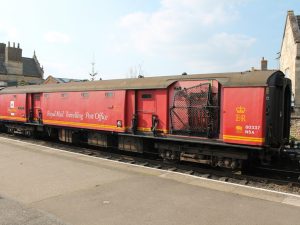Branch AGM, followed by ‘The Story of the Travelling Post Office’, by Roland Gillott, 2nd April 2024
2nd April 2024 Meeting.
For our 2nd April meeting we started with our Branch AGM attended by all six Committee Members and a fair sprinkling of our Branch Members as well as other members and a few non-members. All the Committee were voted back on with no-one volunteering to replace any of us or even wanting to join the Committee!! AGM business was finished after thirty minutes then we welcomed the speaker, Roland Gillott, whose brother Humphrey is a Branch Member.
Roland’s talk was ‘The Story of the Travelling Post Office’.
The Post Office started in 1635 during the reign of King Charles 1 and seven years before the Civil War! It wasn’t until 2nd August 1784 that the post was first carried by stagecoach from Bristol to London. The first train used for mail was in 1830 from Liverpool to Manchester, with the first TPO in 1838 from Birmingham to Liverpool. June 1846 saw the last Horse drawn TPO and by 1914 there were over 130 TPO Services, there were still 77 by 1939, 35 in 1988 and 24 in 1994.
The trains are made up of Stowage Vans where all the bags were loaded and the Sorting Vans where the men worked sorting out the mail as it travelled its route. Some men would do the whole journey from London to Scotland, sleep over and work back the next night and others would work halfway, change trains and work back.

A TPO Sorting Carriage, with mailbag exchange equipment, at the Nene Valley Railway. Image Credit: Roland Gillott.
The Exchangers, which would catch mailbags on the move and would also put them on the train at speed started in 1838 and finished in 1971.
Most people know about the TPOs due to The Great Train Robbery on 8thAugust 1963 near Cheddington on the WCML where over £2m was taken from one.
In London the Post Office Railway ran underground for over 6 miles from Whitechapel, Liverpool Street, Mount Pleasant, New Oxford Street, Western Delivery Offices and Paddington.
It was designed solely for movement of letters and parcels and operated 19 hours a day, 286 days a year with 23 miles of 2 foot gauge track 70 feet below the streets. It was fully automated with computer controlled trains and carried the Capital’s mails for over 75 years and carried around 4 million letters a day from one end to the other including all stops in just 26 minutes!
An extremely interesting evening with 20 minutes of Q&A at the end left the attendance of 23 going home happy.
Rob Davidson, Branch Secretary
